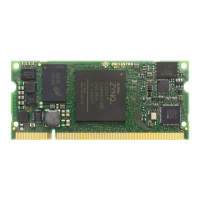2.15.1 QSPI Flash Type
Table 22 describes the memory availability and configuration on the Mars ZX3 SoC module.
The bigger flash device introduced starting with revision 4 has bigger erase sectors (256 kB instead of 4 kB)
and the 4 kB/32 kB/64 kB erase commands are not supported anymore. Further, the programming buffer
is 512 bytes instead of 256 bytes. This may require adjustments of the programming algorithm.
As there is one QSPI flash chip equipped on the Mars ZX3 SoC module, type “single” must be selected when
programming the flash from Vivado tools.
Module Flash Type Size Manufacturer
MA-ZX3 - R1, R2 and R3 W25Q128FVEIG 128 Mbit Winbond
MA-ZX3 - R4 and newer S25FL512S 512 Mbit Cypress (Spansion)
Table 22: QSPI Flash Types
Warning!
Other flash memory devices devices may be equipped in future revisions of the Mars ZX3 SoC module.
Please check the user manual regularly for updates.
2.15.2 Signal Description
The QSPI flash is connected to the PS MIO pins 1-6. Some of the signals are available on the module con-
nector, allowing the user to program the QSPI flash from an external master.
Note that MIO pins 2-6 pins are shared between NAND flash and QSPI flash on the Mars ZX3 SoC module,
therefore only of the two memories may be used at once. However, it is possible to switch between them
at runtime.
Please refer to Section 3 for details on programming the flash memory.
Warning!
Special care must be taken when connecting the QSPI flash signals on the base board. These signals
are shared with the NAND flash and have to be high impedance during normal operation.
Long traces or high capacitance may disturb the data communication between the SoC and the flash
devices.
Note that on the Mars ZX3 SoC module revision 4 and newer, the equipped flash device (Cypress/Spansion)
has a reset signal, which is connected to PS_POR#. Hence, a new method to keep the FPGA in reset is
required during the QSPI flash programming from an external SPI master. Please refer to Section 3.8 for
details.
2.15.3 Configuration
The QSPI flash supports up to 50 MHz operation for standard read. For fast, dual and quad read speed
values, please refer to the flash device datasheet.
D-0000-424-004 27 / 48 Version 05, 21.08.2018

